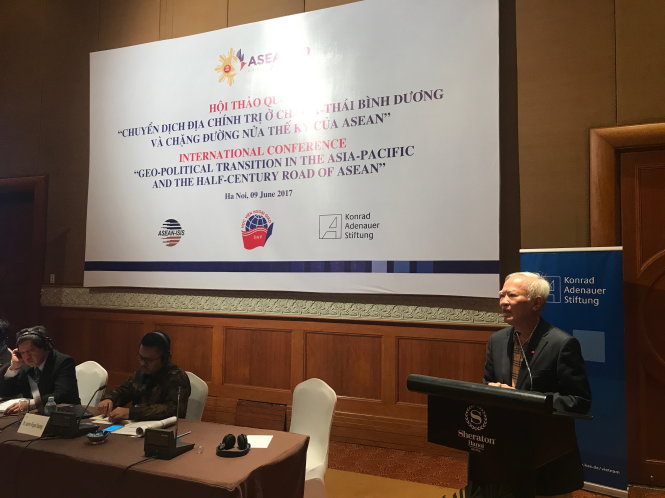The Fourth Industrial Revolution, or Industry 4.0, was named one of the biggest challenges facing ASEAN at a conference in Hanoi on Friday to review the association’s prospects.
ASEAN, or the Association of Southeast Asian Nations, is a ten-country politico-economic bloc whose members include Brunei, Cambodia, Indonesia, Laos, Malaysia, Myanmar, the Philippines, Singapore, Thailand, and Vietnam.
Formed in 1967, the association promotes intergovernmental cooperation and facilitates economic, political, military, educational and cultural integration amongst its members and other countries in Asia.
On Friday, international delegates gathered in the Vietnamese capital for a conference on “geo-political transition in the Asia-Pacific and the half-century road of ASEAN,” hosted by the Diplomatic Academy of Vietnam in cooperation with ASEAN-Institutes of Strategic and International Studies (ASEAN-ISIS) and German-based political foundation Konrad-Adenauer-Stiftung (KAS).
“Will ASEAN be able to grasp the opportunity that Industry 4.0 presents, when most remarkable inventions in the world are not the works of ASEAN countries?” Vu Khoan, former Deputy Prime Minister of Vietnam, asked at Friday’s conference.
“If the answer to that question is no, then we will become obsolete in terms of quality, not quantity,” Khoan said in the audience’s unanimous applause of agreement.
Falling behind
Friday was not the first time the challenges that Industry 4.0 poses to ASEAN had been brought, as it had been thoroughly discussed at the World Economic Forum (WEF) on ASEAN in Cambodia last month.
In an article written for the forum, Shirley Santoso, senior partner at American global management consulting firm A.T. Kearney, stressed that with every industrial revolution there had been a requirement for a skill change, and the same trend was true for Industry 4.0.
“Previous revolutions were seen as job and growth creators; with Industry 4.0 there is a concern that it may eradicate jobs and lead to unemployment,” Santoso wrote.
As other nations lead the charge in embracing the Fourth Industrial Revolution, she said, ASEAN countries have so far failed to keep up, which is particularly worrying given that China, already a manufacturing hub, has a clear plan in place.
While countries such as Vietnam and Thailand have been slowly emerging as manufacturing bases partly due to rising costs in China, the latter is threatening to regain ground with its ‘Made in China 2025’ plan if labor issues and Industry 4.0 are not addressed quickly by ASEAN, she stressed.
The global shift to automation is two-pronged for ASEAN countries, Santoso asserted, in that it grants other countries low-cost production capabilities, while threatening to take away a huge part of human jobs within the grouping.
Vietnam, Cambodia and Indonesia have the highest number of workers at risk from automation, according to a recent declaration by the United Nations’ International Labor Organization (ILO).
“If we take the automotive sector, for example, ASEAN is the seventh largest producer globally, with over 800,000 employed within the sector,” Santoso wrote. “A majority within this sector are low-skill workers; those who will be most affected by automation.”
Retraining is urgent
According to Santoso, Industry 4.0 requires governments in the region to formulate and implement a strategic industrial direction that focuses on developing skills, including private sector partnerships and infrastructure and capital requirements.
She suggested rolling out a nationwide capability and capacity building program in each of the ASEAN countries to cope with the challenge.
“South Korea’s success shows that, with a visionary government that supports its people and implements and monitors close partnerships with private sectors, a workforce can be transformed to unlock huge economic potential,” Santoso wrote.
Indonesia’s Minister of Industry, Airlangga Hartarto, has said that the country’s government would focus on prioritizing policies that aim to shift its manufacturing sector in the face of Industry 4.0.
Hartarto gave an example of the auto industry, where Industry 4.0 could boost production by allowing one assembly line to put together multiple car designs instead of only one as before.
The Indonesian minister added that the country would also place emphasis on educating the people, especially Indonesian youths, about the Internet of Things, while promoting vocational education.
The government of Vietnam has not been inactive toward the impacts and challenges of Industry 4.0.
Last month, Vietnamese Prime Minister Nguyen Xuan Phuc issued a directive on improving Vietnam’s capabilities to embrace the Fourth Industrial Revolution to take a more proactive stance in grasping the opportunities and minimizing the negative impacts of the revolution.
The directive focused on developing Vietnam’s IT infrastructure and encouraging local businesses to upgrade their technologies to catch up with the global trend.
According to Santoso, Singapore has been the exception where, through its SkillsFuture initiative, it has already begun to roll out a capacity-building program to brace for the coming Industry 4.0.
Industry 4.0’s four challenges for Vietnam
According to Vu Khoan, Vietnam is faced with four big challenges with the advent of the Fourth Industrial Revolution.
Firstly, Vietnam’s manufacturing base has yet to complete its transformation from the previous industrial revolutions.
This is demonstrated by the fact that Industry 1.0, 2.0, and 3.0 are still observable here and there across the country, due largely to inequality in industrial development between different areas.
Secondly, Vietnam’s human resource is limited in terms of quality.
Industry 4.0 is made possible by the amount of intelligence put into inventions and innovations, Khoan said, an area where Vietnamese workers find themselves at a disadvantage compared to their regional peers.
Thirdly, the way of life and attitude at the workplace of the Vietnamese population can pose a challenge to their ability to catch up with the fast-changing world of Industry 4.0.
Lastly, the destruction of human jobs by Industry 4.0, especially in the fields of agriculture and handmade artifacts can create social insecurity and unemployment, placing pressure on Vietnam’s welfare system.
Like us on Facebook or follow us on Twitter to get the latest news about Vietnam!























































